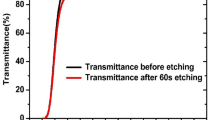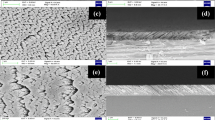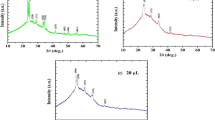Abstract
It is hypothesized that increasing the glancing angle deposition (GLAD) will increase the porosity of WO3 thin film, thus allowing for better ion diffusion. However, beyond a certain GLAD angle, the film follows a reverse trend and grows quite dense, which is attributable to the highly inclined columnar structure. Consequently, finding an optimal GLAD angle that can produce a perfect porous WO3 film under the given experimental conditions is critical. In this context, WO3 thin films, each 400 nm thick, are fabricated using e-beam evaporation at GLAD angle α = 0° (planar), 30°, 55°, 65°, 70° and 80° on fluorine-doped tin oxide (FTO)-coated substrates and Corning glass substrates. The crystalline structure, surface morphology, optical, electrochemical and electrochromic characteristics of the WO3 thin films are all investigated in detail. Film fabricated at a GLAD angle of 65° showed optimal optical transmittance of 75%, band gap of 3.25 eV, highest coloration efficiency (CE) of 31.06 cm2/C and highest diffusion coefficient (D) of 7.215 × 10–4 cm2/s. In conclusion, it may be inferred that the optimal GLAD angle under the current experimental conditions is 65°, which could give an ideally porous WO3 film with novel electrochromic behavior.
Graphical Abstract
















Similar content being viewed by others
References
D.R. Rosseinsky and R.J. Mortimer, Electrochromic systems and the prospects for devices. Adv. Mater. 13, 783 (2001).
M. Buyan, P.A. Brühwiler, A. Azens, G. Gustavsson, R. Karmhag, and C.G. Granqvist, Facial warming and tinted helmet visors. Int. J. Ind. Ergon. 36, 11 (2006).
H. Demiryont and D. Moorehead, Electrochromic emissivity modulator for spacecraft thermal management. Sol. Energy Mater. Sol. Cells 93, 2075 (2009).
L. Pan, Q. Han, Z. Dong, M. Wan, H. Zhu, Y. Li, and Y. Mai, Reactively sputtered WO3 thin films for the application in all thin film electrochromic devices. Electrochim. Acta 328, 135107 (2019).
M. Penza, G. Cassano, and F. Tortorella, Gas recognition by activated WO3 thin-film sensors array. Sens. Actuators B Chem. 81, 115 (2001).
P.V. Karthik Yadav, B. Ajitha, Y.A.K. Reddy, V.R. Minnam Reddy, M. Reddeppa, and M.D. Kim, Effect of sputter pressure on UV photodetector performance of WO3 thin films. Appl. Surf. Sci. 536, 147947 (2021).
H. Zheng, Y. Tachibana, and K. Kalantar-Zadeh, Dye-sensitized solar cells based on WO3. Langmuir 26, 19148 (2010).
V. Hariharan, B. Gnanavel, R. Sathiyapriya, and V. Aroulmoji, A review on tungsten oxide (WO3) and their derivatives for sensor applications. Int. J. Adv. Sci. Eng. 5, 1163 (2019).
Y. Yang, D. Kim, and P. Schmuki, Lithium-ion intercalation and electrochromism in ordered V2O5 nanoporous layers. Electrochem. Commun. 13, 1198 (2011).
P. Ashrit, Transition metal oxide thin film based chromogenics and devices, 1st ed., (Amsterdam: Elsvier Ltd., 2017).
Y. Liu, Y. Lv, Z. Tang, L. He, and X. Liu, Highly stable and flexible ITO-free electrochromic films with Bi-functional stacked MoO3/Ag/MoO3 structures. Electrochim. Acta 189, 184 (2016).
J. Gutpa, H. Shaik, K.N. Kumar, and S. Abdul, PVD techniques proffering avenues for fabrication of porous tungsten oxide (WO3) thin films: a review. Mater. Sci. Semicond. Process. 143, 106534 (2022).
T. Motohiro and Y. Taga, Thin film retardation plate by oblique deposition. Appl. Opt. 28, 2466 (1989).
M.Z. Ahmad, A. Wisitsoraat, A.S. Zoolfakar, R.A. Kadir, and W. Wlodarski, Investigation of RF sputtered tungsten trioxide nanorod thin film gas sensors prepared with a glancing angle deposition method toward reductive and oxidative analytes. Sens. Actuators B Chem. 183, 364 (2013).
M.M. Hawkeye and M.J. Brett, Glancing angle deposition: fabrication, properties, and applications of micro—and nanostructured thin films. J. Vac. Sci. Technol. A Vac. Surf. Films 25, 1317 (2007).
M.T. Taschuk, M.M. Hawkeye, and M.J. Brett, Glancing angle deposition, 3rd ed., (Amsterdam: Elsevier Ltd., 2010).
M.M. Hawkeye, M.T. Taschuk, and M.J. Brett, Glancing angle deposition of thin films: engineering the nanoscale, 1st ed., (New York: Wiley, 2014).
C.T. Kresge, M.E. Leonowicz, W.J. Roth, J.C. Vartuli, and J.S. Beck, Ordered mesoporous molecular sieves synthesized by a liquid-crystal template mechanism. Nature 359, 710 (1992).
J. Gupta, H. Shaik, and K.N. Kumar, A review on the prominence of porosity in tungsten oxide thin films for electrochromism. Ionics 27, 2307 (2021).
K. Robbie and M.J. Brett, Sculptured thin films and glancing angle deposition: growth mechanics and applications. J. Vac. Sci. Technol. A Vac. Surf. Films 15, 1460 (1997).
C. Charles, N. Martin, and M. Devel, Optical properties of nanostructured WO3 thin films by glancing angle deposition: comparison between experiment and simulation. Surf. Coat. Technol. 276, 136 (2015).
G. Beydaghyan, G. Bader, and P.V. Ashrit, Electrochromic and morphological investigation of dry-lithiated nanostructured tungsten trioxide thin films. Thin Solid Films 516, 1646 (2008).
J. Ollitrault, N. Martin, J.Y. Rauch, J.B. Sanchez, and F. Berger, Improvement of ozone detection with GLAD WO3 films. Mater. Lett. 155, 1 (2015).
Y. Pihosh et al., Nanostructured WO3/BiVO4 photoanodes for efficient photoelectrochemical water splitting. Small 10, 3692 (2014).
M. Horprathum, P. Eiamchai, J. Kaewkhao, C. Chananonnawathorn, V. Patthanasettakul, S. Limwichean, N. Nuntawong, and P. Chindaudom, in AIP Conference Proceedings (2014), p. 7
S. Li, Z. Yao, J. Zhou, R. Zhang, and H. Shen, Fabrication and characterization of WO3 thin films on silicon surface by thermal evaporation. Mater. Lett. 195, 213 (2017).
D. Evecan and E. Zayim, Highly uniform electrochromic tungsten oxide thin films deposited by e-beam evaporation for energy saving systems. Curr. Appl. Phys. 19, 198 (2019).
S.I. Boyadjiev, V. Georgieva, N. Stefan, G.E. Stan, N. Mihailescu, A. Visan, I.N. Mihailescu, C. Besleaga, and I.M. Szilágyi, Characterization of PLD grown WO3 thin films for gas sensing. Appl. Surf. Sci. 417, 218 (2017).
K. Kazuhiro and S. Shigeo, Physical properties of tungsten oxide films deposited by a reactive sputtering method. Jpn. J. Appl. Phys. 30, 1841 (1991).
J.C. Sit, D. Vick, K. Robbie, and M.J. Brett, Thin film microstructure control using glancing angle deposition by sputtering. J. Mater. Res. 14, 1197 (1999).
J. Lintymer, N. Martin, J.M. Chappé, P. Delobelle, and J. Takadoum, Nanoindentation of chromium zigzag thin films sputter deposited. Surf. Coat. Technol. 200, 269 (2005).
N. Maiti, P. Karmakar, U. D. Barve, and A. V. Bapat, in Journal of Physics: Conference Series (2008), p. 012049.
D. Işik, M. Ak, and C. Durucan, Structural, electrochemical and optical comparisons of tungsten oxide coatings derived from tungsten powder-based sols. Thin Solid Films 518, 104 (2009).
D.X. Ye, Y.P. Zhao, G.R. Yang, Y.G. Zhao, G.C. Wang, and T.M. Lu, Manipulating the column tilt angles of nanocolumnar films by glancing-angle deposition. Nanotechnology 13, 615 (2002).
R.N. Tait, T. Smy, and M.J. Brett, Modelling and characterization of columnar growth in evaporated films. Thin Solid Films 226, 196 (1993).
A. Zarzycki, K. Dyndał, M. Sitarz, J. Xu, F. Gao, K. Marszałek, and A. Rydosz, Influence of GLAD sputtering configuration on the crystal structure, morphology, and gas-sensing properties of the WO3 films. Coatings 10, 1 (2020).
K.J. Patel, C.J. Panchal, V.A. Kheraj, and M.S. Desai, Growth, structural, electrical and optical properties of the thermally evaporated tungsten trioxide (WO3) thin films. Mater. Chem. Phys. 114, 475 (2009).
V. Madhavi, P. Kondaiah, O.M. Hussain, and S. Uthanna, Structural, optical and electrochromic properties of RF magnetron sputtered WO3 thin films. Physica B 454, 141 (2014).
R.S. Vemuri, M.H. Engelhard, and C.V. Ramana, Correlation between surface chemistry, density, and band gap in nanocrystalline WO3 thin films. ACS Appl. Mater. Interfaces. 4, 1371 (2012).
P.P. González-Borrero, F. Sato, A.N. Medina, M.L. Baesso, A.C. Bento, G. Baldissera, C. Persson, G.A. Niklasson, C.G. Granqvist, and A. Ferreira Da Silva, Optical band-gap determination of nanostructured WO3 film. Appl. Phys. Lett. 96, 10 (2010).
M. Aez et al., A review on the visible light active titanium dioxide photocatalysts for environmental applications. Appl. Catal. B 125, 331 (2012).
J. Yuan, B. Wang, H. Wang, Y. Chai, Y. Jin, H. Qi, and J. Shao, Electrochromic behavior of WO3 thin films prepared by GLAD. Appl. Surf. Sci. 447, 471 (2018).
V. R. Buch, A. K. Chawla, and S. K. Rawal, in Materials Today: Proceedings (2016), p. 1429.
B.S. Lee, R. Deshpande, P.A. Parilla, K.M. Jones, B. To, A.H. Mahan, and A.C. Dillon, Crystalline WO3 nanoparticles for highly improved electrochromic applications. Adv. Mater. 80401, 763 (2006).
K. Naveen Kumar, H. Shaik, Sathish, V. Madhavi, and S. Abdul Sattar, in IOP Conference Series: Materials Science and Engineering (2020), p. 012147.
A. Dolatshahi-Pirouz, M.B. Hovgaard, K. Rechendorff, J. Chevallier, M. Foss, and F. Besenbacher, Scaling behavior of the surface roughness of platinum films grown by oblique angle deposition. Phys. Rev. B Condens. Matter. Mater. Phys. 77, 1 (2008).
J.N. Sun, Y.F. Hu, W.E. Frieze, and D.W. Gidley, Characterizing porosity in nanoporous thin films using positronium annihilation lifetime spectroscopy. Radiat. Phys. Chem. 68, 345 (2003).
A. Barranco, A. Borras, A.R. Gonzalez-Elipe, and A. Palmero, Perspectives on oblique angle deposition of thin films: from fundamentals to devices. Prog. Mater Sci. 76, 59 (2016).
A. H. Jayatissa and S. Te Cheng, in Proceedings of the IEEE Conference on Nanotechnology (2002), p. 25.
Acknowledgments
Our sincere thanks to All India Council for Technical Education (AICTE), New Delhi, India, for providing research funding. Ref: 8-39/RIFD/RPS/POLICY-1/2016-2017.
Funding
Financial support by AICTE is acknowledged. This study was funded by All India Council for Technical Education (AICTE), New Delhi, for providing research funding. Ref: 8-39/RIFD/RPS/POLICY-1/2016-2017.
Author information
Authors and Affiliations
Contributions
We confirm that the manuscript has been read and approved by all named authors. We also confirm that the order of authors listed in the manuscript has been approved by all named authors. Jyothi Gupta: Investigation, Methodology, Validation. Habibuddin Shaik: Conceptualization, Methodology, Supervision, Funding acquisition, Project administration. K Naveen Kumar: Investigation, Methodology, Validation. Sheik Abdul Sattar: Investigation, Methodology, Validation
Corresponding author
Ethics declarations
Conflict of interest
We confirm that there are no known conflicts of interest associated with this publication.
Additional information
Publisher's Note
Springer Nature remains neutral with regard to jurisdictional claims in published maps and institutional affiliations.
Rights and permissions
Springer Nature or its licensor (e.g. a society or other partner) holds exclusive rights to this article under a publishing agreement with the author(s) or other rightsholder(s); author self-archiving of the accepted manuscript version of this article is solely governed by the terms of such publishing agreement and applicable law.
About this article
Cite this article
Gutpa, J., Shaik, H., Naveen Kumar, K. et al. Optimization of GLAD Angle for E-Beam-Fabricated Tungsten Oxide (WO3) Thin Films Towards Novel Electrochromic Behavior. J. Electron. Mater. 52, 653–668 (2023). https://doi.org/10.1007/s11664-022-10036-8
Received:
Accepted:
Published:
Issue Date:
DOI: https://doi.org/10.1007/s11664-022-10036-8




